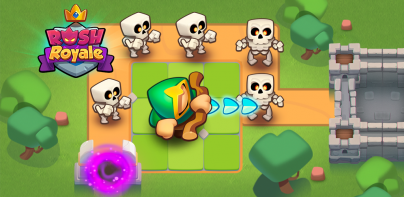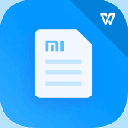


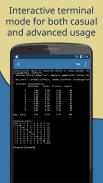
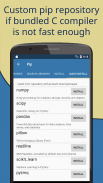
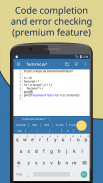
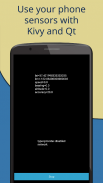
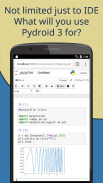
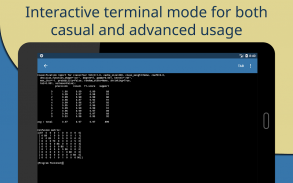
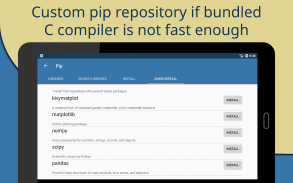
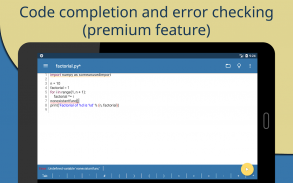
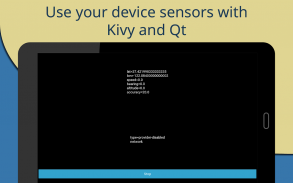
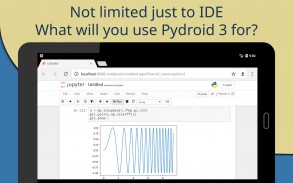
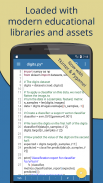
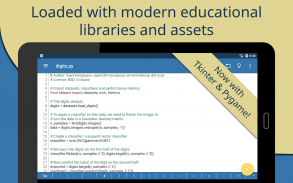
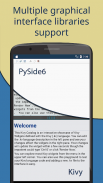
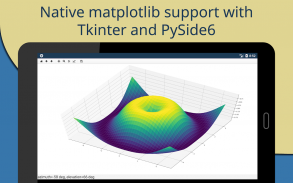
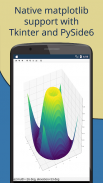
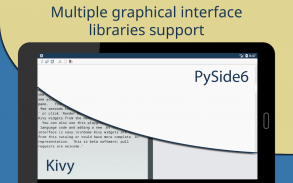
Pydroid 3 - IDE for Python 3

Beschreibung von Pydroid 3 - IDE for Python 3
Pydroid 3 is the most easy to use and powerful educational Python 3 IDE for Android.
Features:
- Offline Python 3.7 interpreter: no Internet is required to run Python programs.
- Pip package manager and a custom repository for prebuilt wheel packages for enhanced scientific libraries, such as numpy, scipy, matplotlib, scikit-learn and jupyter.
- OpenCV is now available (on devices with Camera2 API support). *
- Tensorflow is also available. *
- Examples available out-of-the-box for quicker learning.
- Complete Tkinter support for GUI.
- Full-featured Terminal Emulator, with a readline support (available in pip).
- Built-in C, C++ and even Fortran compiler designed specially for Pydroid 3. It lets Pydroid 3 build any library from pip, even if it is using native code. You can also build & install dependencies from a command line.
- Cython support.
- PDB debugger with breakpoints and watches.
- Kivy graphical library with a shiny new SDL2 backend.
- PyQt5 support available in Quick Install repository along with matplotlib PyQt5 support with no extra code required.
- Matplotlib Kivy support available in Quick Install repository.
- pygame_sdl2 support (SDL2-based pygame implementation).
Editor features:
- Code prediction, auto indentation and real time code analysis just like in any real IDE. *
- Extended keyboard bar with all symbols you need to program in Python.
- Syntax highlighting & themes.
- Tabs.
- Enhanced code navigation with interactive assignment/definition gotos.
- One click share on Pastebin.
* Features marked by asterisk are available in Premium version only.
Quick manual.
Pydroid 3 requires at least 200MB free internal memory. 220MB+ is recommended. More if you are using heavy libraries such as scipy.
To run debug place breakpoint(s) clicking on the line number.
Kivy is detected with “import kivy”, “from kivy“ or "#Pydroid run kivy”.
PyQt5 is detected with “import PyQt5”, “from PyQt5“ or "#Pydroid run qt”.
The same for sdl2, tkinter and pygame.
There is a special mode "#Pydroid run terminal" to ensure your program runs in terminal mode (this is useful with matplotlib that automatically runs in GUI mode)
Why are some libraries premium-only?
These libraries were extremely hard to port, so we had to ask another developer to do that. Under agreement, his forks of these libraries are provided to the premium users only. If you would like to develop free forks of these libraries - contact us.
Take a part in development of Pydroid 3 by reporting bugs or providing feature requests to us. We appreciate that.
As Pydroid 3 main goal is to help user learn Python 3 programming language, our first priority is porting scientific libraries (so system-related libraries are ported only when they are used as dependencies of some other educational package).
Legal information.
Some binaries in Pydroid 3 APK are licensed under (L)GPL, email us for the source code.
GPL pure Python libraries bundled with Pydroid 3 are considered to be coming in the source code form already.
Pydroid 3 doesn’t bundle any GPL-licensed native modules to avoid automatic import of them. The famous example of such library is GNU readline, that can be installed using pip.
Samples available in the application are free for educational usage with one exception: they, or their derivative works, cannot be used in any competing products (in any way). If you are unsure, whether your app is affected by this restriction, always ask for a permission via email.
Android is a trademark of Google Inc.
Pydroid 3 ist die benutzerfreundlichste und leistungsfähigste pädagogische Python 3-IDE für Android.
Eigenschaften:
- Offline-Python 3.7-Interpreter: Zum Ausführen von Python-Programmen ist kein Internet erforderlich.
- Pip Package Manager und ein benutzerdefiniertes Repository für vorgefertigte Radpakete für erweiterte wissenschaftliche Bibliotheken wie Numpy, Scipy, Matplotlib, Scikit-Learn und Jupyter.
- OpenCV ist jetzt verfügbar (auf Geräten mit Camera2 API-Unterstützung). *
- Tensorflow ist ebenfalls erhältlich. *
- Sofort einsatzbereite Beispiele für schnelles Lernen.
- Vollständige Tkinter-Unterstützung für die GUI.
- Voll ausgestatteter Terminal-Emulator mit Readline-Unterstützung (verfügbar in pip).
- Eingebauter C-, C ++ - und sogar Fortran-Compiler, der speziell für Pydroid 3 entwickelt wurde. Damit kann Pydroid 3 jede Bibliothek aus pip erstellen, selbst wenn nativer Code verwendet wird. Sie können Abhängigkeiten auch über eine Befehlszeile erstellen und installieren.
- Cython-Unterstützung.
- PDB-Debugger mit Haltepunkten und Uhren.
- Kivy-Grafikbibliothek mit einem glänzenden neuen SDL2-Backend.
- PyQt5-Unterstützung im Quick Install-Repository zusammen mit matplotlib PyQt5-Unterstützung verfügbar, ohne dass zusätzlicher Code erforderlich ist.
- Matplotlib Kivy-Unterstützung im Quick Install-Repository verfügbar.
- Unterstützung von pygame_sdl2 (SDL2-basierte Pygame-Implementierung).
Editor-Funktionen:
- Code-Vorhersage, automatische Einrückung und Echtzeit-Code-Analyse wie in jeder echten IDE. *
- Erweiterte Tastaturleiste mit allen Symbolen, die Sie in Python programmieren müssen.
- Syntax-Hervorhebung & Themen.
- Tabs.
- Verbesserte Code-Navigation mit interaktiven Zuweisungs- / Definitions-GOTOS.
- Mit einem Klick auf Pastebin teilen.
* Mit einem Stern gekennzeichnete Funktionen sind nur in der Premium-Version verfügbar.
Kurzanleitung.
Pydroid 3 benötigt mindestens 200 MB freien internen Speicher. 220 MB + wird empfohlen. Mehr, wenn Sie schwere Bibliotheken wie scipy verwenden.
Klicken Sie auf die Zeilennummer, um einen oder mehrere Debug-Haltepunkte auszuführen.
Kivy wird mit "Import Kivy", "From Kivy" oder "#Pydroid Run Kivy" erkannt.
PyQt5 wird mit "PyQt5 importieren", "aus PyQt5" oder "#Pydroid run qt" erkannt.
Das gleiche gilt für SDL2, Tkinter und Pygame.
Es gibt einen speziellen Modus "#Pydroid run terminal", um sicherzustellen, dass Ihr Programm im Terminalmodus ausgeführt wird (dies ist nützlich bei matplotlib, die automatisch im GUI-Modus ausgeführt wird).
Warum sind einige Bibliotheken nur Premium-Bibliotheken?
Diese Bibliotheken waren extrem schwer zu portieren, daher mussten wir einen anderen Entwickler bitten, dies zu tun. Nach Absprache werden seine Gabeln dieser Bibliotheken nur den Premium-Nutzern zur Verfügung gestellt. Wenn Sie kostenlose Gabeln für diese Bibliotheken entwickeln möchten, kontaktieren Sie uns.
Nehmen Sie an der Entwicklung von Pydroid 3 teil, indem Sie uns Fehler melden oder Funktionsanfragen stellen. Wir wissen das zu schätzen.
Da es das Hauptziel von Pydroid 3 ist, dem Benutzer das Erlernen der Programmiersprache Python 3 zu erleichtern, liegt unsere erste Priorität in der Portierung wissenschaftlicher Bibliotheken (daher werden systembezogene Bibliotheken nur dann portiert, wenn sie als Abhängigkeiten eines anderen Bildungspakets verwendet werden).
Rechtsinformation.
Einige Binärdateien in Pydroid 3 APK sind unter (L) GPL lizensiert. Senden Sie uns eine E-Mail mit dem Quellcode.
GPL-reine Python-Bibliotheken, die mit Pydroid 3 gebündelt sind, werden als bereits im Quellcode enthalten angesehen.
Pydroid 3 bündelt keine GPL-lizenzierten nativen Module, um einen automatischen Import zu vermeiden. Das berühmte Beispiel für eine solche Bibliothek ist GNU readline, das mit pip installiert werden kann.
Muster, die in der Anwendung verfügbar sind, können mit einer Ausnahme kostenlos für Bildungszwecke verwendet werden: Sie oder ihre abgeleiteten Werke können (in keiner Weise) in konkurrierenden Produkten verwendet werden. Wenn Sie sich nicht sicher sind, ob Ihre App von dieser Einschränkung betroffen ist, fragen Sie immer per E-Mail nach einer Erlaubnis.
Android ist eine Marke von Google Inc.








